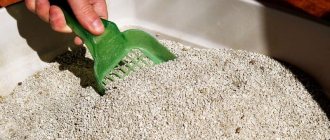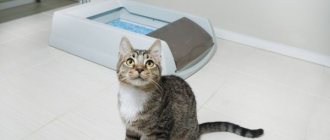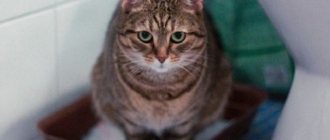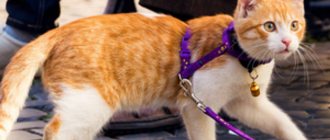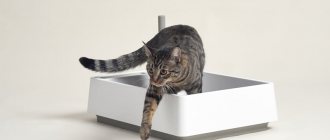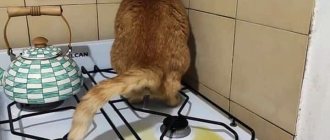Some irregularities in the frequency and type of your cat's stool are normal. This is often observed in cats on a homemade diet, when the owner decided to pamper his pet with goodies from the common table. Constipation often occurs in older cats that are experiencing hormonal changes throughout the body. In other cases, it is worth remembering that normally a cat goes to the toilet once a day. Normally, her stool has a well-formed shape and a moderately dense structure.
Irregular bowel movements or hardening of stool can cause constipation. In this case, you should carefully monitor your pet and if constipation lasts more than two or three days, immediately contact a veterinarian.
First, make sure your cat doesn't actually go to the toilet.
If your cat has access to the yard, she can do her business there, even if there is a litter box at home. But even with cats living in an apartment, this may not be so easy to figure out. Dried feces may have little or no odor and may be difficult to detect, such as in corners. Stress, changes in the home (a new pet, guests, and even rearranging furniture), an uncleaned litter box, etc. can contribute to a change in toilet location.
If you are in doubt whether your cat defecates daily or not, catch it and carefully feel its underbelly. If it is hard and tense, then most likely the cat really cannot go to the toilet for several days.
What is considered constipation?
Constipation (constipation) - irregular bowel movements with increased intervals, the feces are dry and dense. Chronic and episodic constipation can be distinguished. Chronic refers to regular or recurrent episodes of difficult bowel movements. Constipation is called episodic if it happened once and after solving the problem did not recur. Older animals with other chronic diseases are more susceptible to chronic constipation. Episodic constipation can happen at any age.
Reasons why your cat doesn't go to the toilet for several days
The most likely problem is constipation. This is a disease of the gastrointestinal (GI) tract which cat feces are unable to pass through the intestines, accumulating in the colon and causing pain and sometimes injury.
The main causes of constipation in cats are:
- Poor nutrition. Cats are carnivores and their main source of nutrition is animal protein. However, fiber is also important for good digestion of food. Whether it’s specialized food from a store or homemade food, carefully study the composition or select products so that your pet receives all the necessary substances.
- Injury. If a cat falls, gets hit by a car, or is otherwise injured, it can damage the gastrointestinal tract.
- Intestinal blockage. The intestines can become clogged not only with feces, but also with hairballs that the cat was unable to get rid of earlier. Also, threads and tinsel that pets tried to play with are often found in the intestines.
- Hormonal imbalance. If your cat has thyroid or metabolic problems, this may affect the colon's inability to contract, leading to constipation.
- Obesity. Overweight cats often have gastrointestinal problems.
- Intestinal inflammation. Diarrhea in this case is much more common, but constipation is also possible.
- Dehydration. Water is vital for a cat to survive and function in all body systems. This is especially important if dry food predominates in her diet. When there is not enough water, feces are not lubricated enough, causing constipation.
- Kidney disease. If the kidneys are not functioning properly, they may not pass enough water into the colon. In these cases, constipation may be caused by dehydration of feces as they pass through the intestines.
How to help a cat yourself
Fortunately, much more often a cat does not go to the litter box for a long time for reasons not related to illness. What to do in this case? How to help an animal? It all depends on the situation. Sometimes you just have to wait. For example, if the cat “forgot” about the litter box due to severe stress. As soon as the frightened animal “crawls out from under the sofa” and comes to its senses, the “toilet” problem will be solved by itself.
The same applies to the postpartum period in cats. Here you can try to speed up recovery by offering your pet liquid meals. If the reason for the long absence of bowel movements is sexual arousal, you can also just wait it out, or you can help the animal by giving him libido-reducing pills or finding a “mate.” The last option will work, but not for long. The best solution and guarantee of getting rid of pain is sterilization.
If there is a suspicion of hair accumulation in the gastrointestinal tract, cats are given a little Vaseline oil. Of course, the animal is unlikely to eat it of its own free will. However, you need to try to pour a small amount of the product into its mouth, holding it with your hands so that the pet swallows the oil. Literally a day later, the pet will feel the urge to defecate and visit the litter box.
If a cat does not go to the toilet for 5 days, and no serious health problems have been identified, then constipation is a situational phenomenon. It can cause serious damage to the body, so you should not pull it. It is allowed to give the cat a laxative such as Duphalac or do a cleansing enema.
© shutterstock
It is advisable to consult a doctor regarding both the first and the second. Most often, the cause of constipation is errors in the diet. What and how to feed your cat so that it goes to the toilet normally is described below.
Symptoms of constipation in cats
These include:
- Tense stomach;
- Lack of appetite;
- Signs of pain/discomfort;
- Straining during bowel movements;
Constipation can be acute or chronic . In cases of severe constipation, cats typically strain during bowel movements, causing red blood to be seen in the stool.
There is no point in waiting for everything to resolve itself, because long-term constipation can end in disaster - intestinal ruptures, intoxication and other troubles. So take your pet to the vet as soon as possible.
Diagnostics
To diagnose and establish an accurate diagnosis, various techniques will be required. First of all, the doctor will collect a detailed life history: how old the animal is, a detailed diet, treatment for parasites, past diseases, living conditions. Next, you will need a medical history: what exactly is bothering you, how long ago it happened, what the stool looks like, and whether there are any other complaints besides constipation. Then the doctor will examine the animal, perform palpation of the abdomen and rectal examination.
Additional research may be required. An abdominal x-ray will show the amount of stool in the intestines, contrast-enhancing foreign objects (for example, undigested bones) or evidence of non-contrast foreign bodies, mass formations, and dilation of the colon. An X-ray of the pelvic area will show whether there are any anatomical changes in the pelvic bones or improperly healed fractures. The doctor may also prescribe a study with the injection of a radiopaque contrast agent; it will show whether intestinal patency is preserved. An ultrasound of the abdominal cavity will show the presence of neoplasms, inflammatory processes in the intestines, and will help assess whether peristalsis in the intestines is preserved in various sections.
General clinical and biochemical blood tests can also help make a diagnosis (for example, kidney disease). A stool test can show the presence of parasites. In rare cases, computer or magnetic resonance imaging or rectocolonoscopy may be indicated.
How to Prevent Constipation in Cats
- Make sure your cat has constant access to fresh water.
- Main risk factors: weight and age. Do not overfeed your pet and create conditions for an active lifestyle.
- Do not scatter threads, tinsel and other things that the cat likes to chew and swallow.
- Adjust the animal's diet. If your pet eats dry food, sometimes offer him wet food of the same brand. Make sure he doesn't overeat.
- Regular examinations at the veterinary clinic will help identify diseases in the early stages and treat them.
*****
Photo source -
Prevention: food for proper bowel function
Preventive procedures include:
- visit the veterinarian at least 2 times a year;
- active lifestyle of the pet and walks in the air;
- proper nutrition;
- Regular brushing of fur.
Owners of cats and kittens should remember that their pet should not be overfed. This is especially true for castrated animals. A special balanced diet has been developed for them.
What can you feed your cat if he is constipated?
To quickly restore the functioning of the digestive tract, the animal’s body must receive proteins and fiber. The diet does not include eggs, cheese or rice. These products aggravate the condition of the sick animal.
To improve intestinal function, it is recommended to give diluted store-bought condensed milk with water up to 3-4 times a day. Vaseline oil is given once a day on an empty stomach; for prolonged constipation, the dosage frequency is increased to 2-3 times.
Important! Only Vaseline oil can help with constipation in a cat. Oral use of sunflower, olive, and castor oil for therapeutic purposes is prohibited. These products are harmful to the animal's body.
Enema appointment
In severe cases, when visiting a veterinary clinic, the doctor recommends the use of an enema. The cleansing process takes place under the supervision of doctors in the clinic in the following sequence:
Healthy cat
- an hour and a half before the procedure, the animal takes 3 ml of vaseline oil;
- Next, prepare an enema solution at room temperature;
- the tip is lubricated with Vaseline oil, the solution is drawn up and inserted into the cat’s anus in a circular motion;
- At the end of the procedure, the pet’s anus is clamped with the tail for 20 minutes and only after that the animal is released to the toilet.
It is necessary to understand that douching is a very painful and unpleasant procedure for the animal. It is prohibited to carry it out if the pet has skin disorders around the anus, as well as bleeding and cardiovascular diseases. In addition, douching is not performed on pregnant cats.
Important! Frequent enemas disrupt the intestinal microflora and injure the pet's anus.
Help for newborn kittens
Young kittens often have problems with bowel movements. The fact is that kids need outside help. A cat should lick her babies not only to clean their fur. A gentle massage stimulates the intestines and ensures blood flow. Licking helps the kitten get rid of the contents of the intestines, because he cannot do this on his own.
In the case when a young and inexperienced mother refuses to care for her offspring, a person must help. Help may also be required if the adopted kitten is one month old or less.
In order to perform a massage, you need to take a small piece of soft cloth or cotton wool and moisten it with warm water. Now make short longitudinal movements from chest to tail across the entire tummy. Movements should be very soft, gentle, not causing discomfort to the kitten. There is no need to press on the tummy, just stroke it.
First aid for an animal with constipation
It is necessary to reduce the load on the intestines by stopping feeding your pet for a couple of days. At the same time, he must consume enough fluid to soften the stool. If the cat refuses water, he needs to be given water using a syringe without a needle.
You should not give your animal a laxative without consulting a veterinarian, as improper use of medications can lead to an exacerbation of the inflammatory process. To alleviate your pet's condition before visiting the veterinarian, you can give him Vaseline oil (but only if there is no vomiting).
Kittens often suffer from constipation when separated from their mother early. Therefore, if the kitten does not have stool, you can lightly massage its tummy, moving along to the anus. This massage has a stimulating effect on peristalsis and promotes emptying. But it is better to show the baby to a specialist, because for a fragile body, intoxication can be extremely dangerous, and the kitten’s intestines quickly become clogged with waste. If the baby is not helped in a timely manner, surgical intervention may be necessary.

